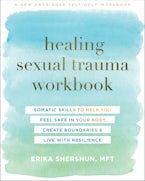By Erika Shershun, MA, MFT, author of Healing Sexual Trauma Workbook
Trauma is the result of experiencing an overwhelming event without the internal and external resources necessary to integrate that experience. Sexual trauma is a particularly devastating trauma. It’s one of the big T traumas, those that are usually life threatening. Sexual trauma is an act of betrayal, humiliation, and injustice. It leaves one feeling vulnerable—often shamed or ashamed, ungrounded, and unsafe. A deep violation that not only wounds one’s mind and body, but also one’s soul.
While writing Healing Sexual Trauma Workbook, I received feedback along the lines of, “there’s just so much.” I couldn’t disagree with the comment; there is “so much” that goes into healing this deep and painful soul wound. I’ve worked with many survivors who, like myself, struggled for years to get the tools and support they needed to do this healing. Making these tools more accessible is what led me to write Healing Sexual Trauma Workbook.
On Working Somatically
Many of the tools, experientials, and practices in Healing Sexual Trauma Workbook are somatic or body-based. This requires listening to and working with your body and what it’s communicating. A large number of survivors automatically numb, disconnect, or dissociate from bodily sensations during and after the traumatic event. Learning to once again feel safe within your skin is foundational to the healing process.
Patterns of bodily constriction bridge your trauma to new situations causing triggers and flashbacks that take you out of the present where life is lived. When you learn to observe and stay with the sensations until they begin to change, the constriction begins to dissolve. Once you’re able to observe and reduce the intensity of your sensations and emotions, you generate choice (which was taken from you), along with reduction and eventually elimination of symptoms.
Healing is not easy, it takes courage and perseverance, but the rewards are worth it. No longer dissociating, feeling numb, or frozen; no longer having your life disrupted by flashbacks or your nervous system hijacked by trauma triggers; no longer living in a perpetual state of hypervigilance and fear; and no longer feeling the debilitating shame that belongs to the perpetrator. Because of this, it is said that healing is the best revenge.
Things to keep in mind while healing:
- Go at your own pace. It’s a process that can’t be rushed. Your body and mind need time to absorb and integrate any new insights, practices, and skills. Give yourself permission to take a break from the work if necessary. If working with a therapist, ask them to slow down as needed.
- Calm and regulate your nervous system. Whenever you start to feel overwhelmed, stop and take time to support your nervous system in feeling safe. A few examples of what this might include are grounding yourself, slowly looking around the space you’re in to see that there’s no real threat, and taking deep yet gentle breaths.
- Cultivate patience and persistence. It’s easy to lose sight of your progress. Take note of the small shifts in intensity and frequency of triggers, dissociation, and flashbacks; and improvements in mood, self-worth, self-agency, and your relationships.
- View setbacks as a necessary part of the process. Don’t misinterpret two steps forward and one step back as validation that you won’t succeed. You’ve simply uncovered another layer of the wound that needs to be processed, you’re moving deeper into your healing.
- Make self-care a daily practice. Take a few minutes to check in with yourself several times throughout the day. You can start with bringing attention to your breath, then take note of what emotions and physical sensations are present—then communicate your needs. Notice if it’s a need you can meet on your own, if you want to make a request, or ask for help from someone else.
- Offer yourself compassion. Adding touch, such as placing your hands on your heart center is soothing to your nervous system. Self-compassion generates self-acceptance, appreciation, confidence, and well-being. When you recognize your intrinsic value, you relax and settle into yourself.
- Remember, healing improves your quality of life. Each step you take on your healing journey is a step toward a better future. Healing’s not only beneficial for you—it can positively impact your relationships, and reverberates to future generations.
Post-traumatic growth
Although it can be hard to accept, our greatest growth most often comes from our deepest suffering. This is not to say that everything happens for a reason; what happened to you should never have happened. Psychologist and author Eduardo Duran sums it up this way: “Everything in the universe is either in balance/harmony or is moving towards harmony…. When suffering arises, it does not arise without the complementary harmonic balance of movement towards greater consciousness and awareness.” As you come out on the other side of your healing journey, my hope is that you’ll be able to say, “What I went through was devastating, and these are the ways I’ve grown and evolved through the hard work I’ve done to heal.”
Einhaeuser, E. 2015. “Eduardo Duran: Healing the Soul Wound.” Synergies in Healing Journal. synergies-journal.com
Erika Shershun, MA, MFT, is a licensed psychotherapist and supervisor working in private practice in San Francisco, CA. She specializes in treating survivors of sexual assault and incest, and, as a survivor herself, facilitates an ongoing weekly therapy group, Surviving & Thriving: Healing Sexual Trauma.



 Part 2: What to Do When a Client Is Participating in Self-Judgment?
Part 2: What to Do When a Client Is Participating in Self-Judgment?